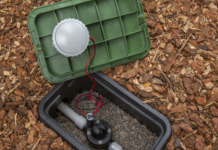 The United States Green Building Council (USGBC) has long been a compass for the sustainable design, construction, and operation of buildings. The Leadership in Energy and Environmental Design (LEED) certification program is the world’s most widely used green building rating system. Since its 1993 introduction, the program has evolved with revisions to the landscape and irrigation category that provide additional point-earning opportunities. With LEED version 4.1, irrigation is specifically associated with three certification types through the Water Efficiency (WE) credit: single-family residential; multi-family residential; and building design and construction.
The United States Green Building Council (USGBC) has long been a compass for the sustainable design, construction, and operation of buildings. The Leadership in Energy and Environmental Design (LEED) certification program is the world’s most widely used green building rating system. Since its 1993 introduction, the program has evolved with revisions to the landscape and irrigation category that provide additional point-earning opportunities. With LEED version 4.1, irrigation is specifically associated with three certification types through the Water Efficiency (WE) credit: single-family residential; multi-family residential; and building design and construction.
Single-Family Residential
Applicants can earn WE credits by incorporating landscapes and irrigation that protect and restore water resources.
The WE Credit: Total Water Use — This credit offers 3 to 15 points depending on the overall indoor and outdoor water use reduction from the baseline. Applicants must use the EPA WaterSense® Water Budget Tool to calculate water savings.
The WE Credit: Outdoor Water Use — Under Option 2 of this credit, applicants can earn 1 to 2 points for implementing efficient irrigation.
Multi-Family Residential
In this category, WE credits are awarded in two ways. Under Option 1, applicants must use the EPA WaterSense Budget Tool to calculate indoor and outdoor water use reductions for the project to earn a range of 1 to 10 points.
Option 2 awards 1 to 3 points depending on the percentage of native or locally adapted plants designated for the project location. In addition, 1 point can be awarded through the WE Credit: Water Metering for metering at least 80% of the landscape area or including meters on reclaimed irrigation systems.
Building Design and Construction
Applicants are given two options for WE credits and may earn a varying number of points depending on the project type: core and shell, healthcare, or non-healthcare.
To earn credits under Option 1, applicants must show that the landscape does not require a permanent irrigation system beyond a maximum 2-year landscape establishment period.
To earn credits under Option 2, applicants must use the EPA WaterSense Water Budget Tool to calculate landscape water requirements. They also need to show a water savings of at least 50% compared to baseline projects. Depending on the project type, they can earn between 1 and 3 points. Additionally, 1 point can be awarded through the WE Credit: Water Metering for metering at least 80% of the landscape area or including meters on reclaimed irrigation systems.
Hunter industries is often asked for product recycled material data to help meet the Material and Resources credits. Unfortunately, LEED specifically excludes mechanical, electrical, and plumbing components from recycled content calculations since they are considered minor, removable materials. Although Hunter products are excluded from this credit, Hunter includes recycled material in its products to help decrease its environmental footprint.
To learn more about Hunter irrigation solutions for LEED projects, check out our LEED Design Guides. While the solutions shown in these guides will help you meet and even exceed LEED requirements, you’ll find them useful for non-LEED projects as well. The practices discussed map out effective irrigation design practices that deliver real-world water efficiency and savings. Whether or not you work on LEED projects, these guides deliver solutions for any project.
For more on landscape water conservation, see Three Essential Irrigation Trends and Water Harvesting To Irrigate Landscapes.











![[VIDEO] Dickies®: Discover Workwear That’s Anything But Uniform](https://turfmagazine.com/wp-content/uploads/2023/06/1647663814-4b1a2a7742790a9b1e97a3b963477850192e1d6a9dfba9b07214a77bae25d6e3-d-218x150.jpg)






























![[VIDEO] Dickies®: Discover Workwear That’s Anything But Uniform](https://turfmagazine.com/wp-content/uploads/2023/06/1647663814-4b1a2a7742790a9b1e97a3b963477850192e1d6a9dfba9b07214a77bae25d6e3-d-324x160.jpg)